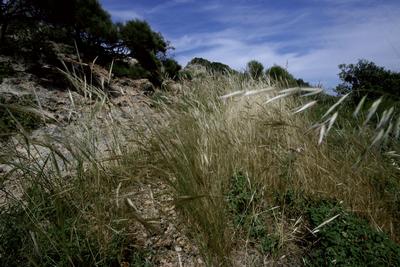Life Ponderat
Species and Habitat
- Home
- Species and habitats
The species we aim to protect

Scopoli's shearwater
Scientific name: Calonectris diomedea
Italian name: Berta maggiore
This migratory seabird reproduces almost exclusively on the reefs of Mediterranean islands. Wintering areas are located in the south of the Atlantic Ocean. In Ventotene Scopoli’s shearwaters are called “marzaiole” because they return to the Ponziane Islands in March. They leave in November, and nesting occurs between May and October. In Ponza instead they are called “parlanti” (i.e. talkers), because of their nocturnal calls recalling the cry of a newborn baby or human voices. The species nests in Palmarola, Ponza, Ventotene, Zannone and S. Stefano. A few couples are also present in Gavi and the Faraglioni of Calzone Muto.

Yelkouan shearwater
Scientific name: Puffinus yelkouan
Italian name: Berta minore
This species is exclusive of Mediterranean and even during migratory movements it never crosses the Strait of Gibraltar. It nests on coastal cliffs and islands. It arrives at the colonies of the Ponziane Islands from late autumn and therefore it is present throughout the winter. It lays its egg in March and the young fly away in July. Birds spend the months from August to October in the Black Sea or in the eastern part of the Mediterranean. The species nests in Palmarola, Ponza, Ventotene and with a few couples also in Zannone and S. Stefano.

Mediterranean storm petrel
Scientific name: Hydrobates pelagicus melitensis
Italian name: Uccello delle tempeste
Endemic subspecies of the Mediterranean, nesting on the most inaccessible cliffs and in deep caverns. The difficulties encountered in the study of this species make it one of the least known. Some individuals are occasionally seen in the Ponziane archipelago, where a true breeding population probably became extinct because of the presence of rats.
The habitats we aim to protect

6220* Pseudo-steppe with grasses and annuals of the Thero-Brachypodietea
Xerophilous herbaceous formations dominated by annual plants (therophytes) that develop in environments with little soil and abundant detritus or rocky outcrops. They can represent primary vegetation or derive from the degradation of potential vegetation (evergreen oak woods and Mediterranean maquis). They occur in all the Ponziane islands, with limited and naturally fragmented extent, usually in mosaic with other Mediterranean vegetation types.

3170* Mediterranean temporary ponds
This habitat occurs in shallow depressions that collect a modest amount of rainwater during autumn and winter. Water evaporates quickly in spring or early summer, and few small plants can grow in these depressions when the soil is still wet. They are generally annual species (therophytes) or small perennial geophytes. Some of these, including species of the genera Juncus and Isoetes, are very rare and strictly linked to this habitat, which normally covers small areas.
In the Ponziane archipelago this habitat occurs over mostly flat terrains with a shallow soil layer.

5320 Low formations of euphorbia close to cliffs
Shrubland vegetation that colonizes the immediate vicinity of sea cliffs and forms the transition between cliff vegetation or clifftop phryganas and thermo-Mediterranean scrub. It is characterized by small shrubs, in particular Helichrysum litoreum and Thymelaea hirsuta. This habitat occurs in all the Ponziane islands, especially in Palmarola and Zannone.

5330 Thermo-Mediterranean and pre-desert scrub
This habitat encloses different Mediterranean formations and scrubland. It is quite common in Italy, with formations dominated by different plant species, depending on the local context and on present or past anthropogenic disturbances (fire, cutting, grazing, etc.). In the Ponziane islands communities dominated by Euphorbia dendroides, Chamaerops humilis, Ampelodesmos mauritanicus and/or Genista tyrrhena represent the most common aspects. This habitat occurs in all the Ponziane islands, especially widespread in Palmarola and Zannone.

1240 Vegetated sea cliffs of the Mediterranean coasts with endemic Limonium spp.
This habitat encompasses cliffs and high coasts characterized by populations of halorupicolous species, which are adapted to the direct contact with seawater and marine aerosols, and capable of settling in rock crevices and fissures. The dominant species are Crithmum maritimum (sea fennel) and some species of the genus Limonium, many of them strictly endemic.

9340 Quercus ilex forests
This forest habitat dominated by holm oak (Quercus ilex) is typical of the Mediterranean, but has almost disappeared from the small Mediterranean islands because of human impact. In Zannone it covers about half of the island, in Palmarola it occurs with three small fragments.
In the Ponziane islands, characterized by low rainfall, strong winds and shallow soils, the forests is composed by evergreen species, adapted to the typical Mediterranean climate. In most of the Italian territory, excluding Sardinia and the coastal areas of the southern regions, the holm oak forests are in general made also by deciduous trees. Therefore, although the habitat is widespread in Italy, the particular type occurring in the island of Zannone (and marginally in Palmarola) is quite rare at national scale and unique among the small Mediterranean islands.